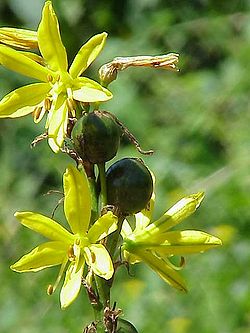| Asphodeline lutea | |
|---|---|
 | |
| Scientific classification | |
| Kingdom: | Plantae |
| Clade: | Tracheophytes |
| Clade: | Angiosperms |
| Clade: | Monocots |
| Order: | Asparagales |
| Family: | Asphodelaceae |
| Subfamily: | Asphodeloideae |
| Genus: | Asphodeline |
| Species: | A. lutea |
| Binomial name | |
| Asphodeline lutea | |
| Synonyms [1] | |
| |


Asphodeline lutea (king's spear, yellow asphodel) is a perennial plant native to southeastern Europe, northern Africa, the Caucasus and the Levant. [1] It is grown as a landscaping plant. [2]
Contents
It has been associated with the Asphodel of the Ancient Greek underworld, [3] but so has the closely related Asphodelus ramosus .